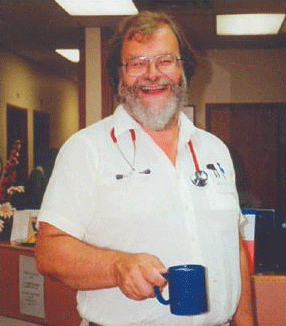Dr Erik Paterson, 1941–2016

Dr Erik Paterson was born in Cambridge, grew up and was educated in Scotland, and qualified from the University of Glasgow School of Medicine in 1960. In 1970 Dr Paterson married the love of his life, Jinty Divens, and they emigrated to Canada’s East Kootenays, where he worked as a GP until 2012. Dr Paterson’s career was interrupted for a year in his mid-50s by acute leukemia and in his mid-60s by chemotherapy and radiation for carcinoma of the prostate. He succumbed to his final illness 2 months after it started, while holidaying in Hawaii.
Dr Paterson was a busy full-time GP with a large obstetrics practice and was an anesthetist at Creston Valley Hospital for 20 years. He was the first life member of the Society of General Practitioners of BC, and he received the Rural Service Award from the Society of Rural Physicians of Canada. He was, however, more than a busy GP. Dr Paterson made an immense commitment to the community of Creston, especially on environmental issues. In 1978 he received the Save the Kootenays Concerned Citizen Award for his leading role in the successful environmental campaign to halt BC Hydro’s Kootenay diversion project. Since 1994 Dr Paterson was trustee for the Mae Baker Bursary Fund, which has helped more than 140 RN and LPN candidates with the cost of education. From 1970 to 1980 he was the founding chair of the Advisory Committee of the Creston Valley Wildlife Management Authority and for many years he judged the Creston School District’s Annual Science Fair.
Though few knew it, the breadth of Dr Paterson’s interests and commitments was even wider. In 1978 he received the Dixie Annette Award from the Huxley Institute for Biosocial Research in New York. He practised chelation therapy and, in 2000, he was certified by the American Board of Chelation Therapy and was admitted into the International Orthomolecular Medicine Hall of Fame. In 1999 he was admitted into the American College for Advancement in Medicine. He concentrated research on the general practice aspects of nutritionally based treatment of disease and presented papers across Canada on numerous occasions.
One of Dr Paterson’s other great loves was space. He was an amateur astronomer, did significant research into studies into the medical implications and economic benefits of large-scale human habitats in space, and presented papers from his research across the US.
Dr Paterson’s father was an Arctic explorer, and Erik was thrilled when asked to represent his father at the 2013 centennial memorial for Ernest Shackleton’s Antarctic expedition.
Jinty played a significant role in the success of Erik’s accomplishments. She was the tactician who organized his work, whether it was in his general practice office or managing his other interests. Jinty did all this while looking after the home and bringing up their two daughters, Tara and Fiona, and later the two grandchildren, Ashley and Hann.
Dr Paterson was loved by all for he had the unique ability to cross generations. As my grandson, Nick, said, “He was one of those epic people one seldom meets for he was always enjoyable and could be a funny dinner companion.”
—John O’Brien-Bell, MBBS
Surrey
